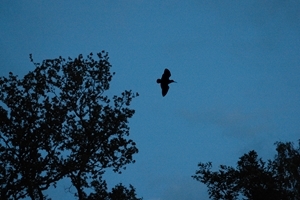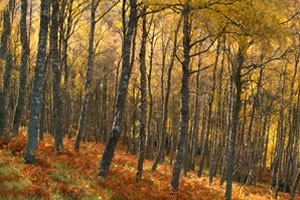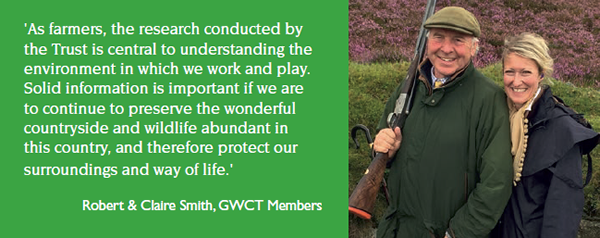Key points
Background
- Around a third of woodland bird species have become rarer over the past 40 years.
- The number of woodcock that breed in Britain fell by 29% between 2003 and 2013. The area in which they breed is also smaller than it was, having dropped by more than half between 1970 and 2010.
- The authors studied woodland structure and the mixture of tree species, along with data from the GWCT/BTO Breeding Woodcock Survey, to identify which woodland features were most important for breeding woodcock.
Findings
- Woodcock were found more often in heavily wooded areas with a mix of woodland habitats.
- Woodcock were more common in woods which were further from urban areas.
- Woodcock were more likely to breed in woods that contain birch stands, and less likely in those dominated by beech.
- These points can help guide further research, and woodland management to benefit woodcock.
Background
 Around a third of Britain’s woodland bird species have declined in the past 40 years. It is thought that this may be because of changes in the types of woodland habitat available, but it is hard to show this with certainty. Most studies so far have focused on migratory species, so it is difficult to separate the effect of habitat change here in the UK from problems affecting the birds on their wintering grounds elsewhere or during migration.
Around a third of Britain’s woodland bird species have declined in the past 40 years. It is thought that this may be because of changes in the types of woodland habitat available, but it is hard to show this with certainty. Most studies so far have focused on migratory species, so it is difficult to separate the effect of habitat change here in the UK from problems affecting the birds on their wintering grounds elsewhere or during migration.
Two distinct groups of Eurasian woodcock (woodcock) are found in the UK – those who breed here and remain here year-round, and those who breed in northern Europe and migrate here to spend the winter. The UK breeding population declined by 29% in ten years between 2003 and 2013, but the migratory population, who only spend the winter here, remained broadly. This suggests that whatever is causing the decline is affecting British birds during the breeding season only, rather than during the winter. Declines in our breeding population appear to be long-term; in 2010, the area of the UK where woodcock bred was less than half that of 1970. This is called a range contraction.
To understand the reasons for woodcock declines and range contractions better, we need to have a clear picture of the habitat they need during the breeding season. Although some studies have looked at this, they have generally looked only at local conditions, rather than a large-scale assessment of habitat across Great Britain.
What they did
Surveys were organised in collaboration with the British Trust for Ornithology. Survey visits were completed by volunteers, who went to preselected woodland sites across the UK and recorded all the woodcock they saw or heard during an hour at dusk. This was done three times between May and June, when woodcock are breeding and the males fly ‘roding’ flights which are easy to identify and associated only with woodcock breeding.
These surveys were carried out on 807 sites in 2003, and on 827 sites in 2013. 544 of these were surveyed in both years, so could be compared. Annual roding woodcock counts are still continued and people wishing to get involved can learn more on the BTO website.
When the volunteers performed woodcock counts, they also examined the vegetation, and estimated the amount of woodland with a closed canopy, the space within woodland (tracks, glades, etc), and non-woodland habitat (fields, etc) within 200m of their survey point. They estimated the most common tree type in the area and the approximate age of the trees. This gave information about the immediate area around where woodcock were displaying. The scientists also looked at information about the wider area, up to 2km around the survey sites. All this information was examined to see what affected the likelihood of woodcock breeding there and their numbers.
The scientists also included information about the distance to the nearest urban area of over 50 hectares (equivalent to a large village), and the abundance of roe, fallow and muntjac deer, which are thought to alter woodland structure and could therefore affect whether habitat is suitable for breeding woodcock.
What they found
 In the immediate area around the survey site (within 200m), woodcock were more often found where there was both closed canopy and some open space. The kind of trees that were present near the survey site was important, with woodcock less likely to be seen in sites mainly made up of beech trees. Sites containing wet woodland, Sitka spruce, other conifer or a mixture of woodland categories more often contained woodcock. When analysed further, it became clear that if birch trees were present, woodcock were more likely to be found. This may explain the association with spruce and other conifers, as conifer woods often contain some birch stands.
In the immediate area around the survey site (within 200m), woodcock were more often found where there was both closed canopy and some open space. The kind of trees that were present near the survey site was important, with woodcock less likely to be seen in sites mainly made up of beech trees. Sites containing wet woodland, Sitka spruce, other conifer or a mixture of woodland categories more often contained woodcock. When analysed further, it became clear that if birch trees were present, woodcock were more likely to be found. This may explain the association with spruce and other conifers, as conifer woods often contain some birch stands.
When looking at the wider area, up to 2km from the survey sites, more woodcock were found when the woodland habitat was more varied, i.e. in woods that included different types of tree and more frequent open areas, rather than those made up of the same kind of trees and the same structure. The effect of particular types of trees, for example broadleaved woodland compared to conifers, depended on the size of the wood.
Despite finding woodcock more often in conifer woodland at a smaller scale, in large areas of woodland they were more likely to be found where woods had more broadleaved trees. It may be that broadleaved woodlands provide better habitat, but are often too small to support breeding woodcock, or that large, mainly coniferous woodlands are more suitable when mixed with some stands of broadleaves (e.g. birch).
Woodcock were more likely to be found where there was less urban area within 2km of the survey site, and in general woodcock abundance was higher in woods further from urban areas.
Table 1: The sites are divided into categories, based on the tree types nearby. A tree type is considered ‘predominant’ if it occupies more than half of the area within 200m of the count point. This table shows the proportion of sites of each type where breeding woodcock were recorded. A total of 689 sites were surveyed.
Predominant tree type
in the nearby blocks |
Percentage of those sites
occupied by woodcock |
| Broadleaf categories |
|
| Beech |
16% |
| Oak (including oak-birch) |
33% |
| Wet woodland |
52% |
| Other broadleaf |
9% |
| Conifer categories |
|
| Sitka spruce |
44% |
| Other conifer |
45% |
| Other categories |
|
Conifer/broadleaf mixed
within blocks |
30% |
Mixture of blocks with different
predominant species |
42% |
| Average |
33% |
What does this mean?
 We know that woodcock need woodland areas to breed in. This study has shown that more woodcock are found in more varied woodlands, those with some areas containing birch trees, and those further from built-up areas. Larger areas of woodland are preferred but this does not have to be in the form of one large, continuous block as long as there is enough woodland overall in the surrounding landscape.
We know that woodcock need woodland areas to breed in. This study has shown that more woodcock are found in more varied woodlands, those with some areas containing birch trees, and those further from built-up areas. Larger areas of woodland are preferred but this does not have to be in the form of one large, continuous block as long as there is enough woodland overall in the surrounding landscape.
The fact that beech woods are less favourable for woodcock and birch more so may be because of the supply of woodcock food. Beech trees are usually found in dry areas, while birch generally grows in wetter areas. Beech leaves are tough and unpalatable to insects and other invertebrates that live in the soil, whereas birch leaves rot down more quickly and easily, and may support more earthworms. Woodcock need areas with soft ground and a plentiful supply of food, which they probe for with their bill, so areas with birch trees are more likely to provide a suitable habitat. Stands of young birch trees also tend to be very dense, so may offer more protection from the elements and from birds of prey.
A mixture of different kinds of trees, interspersed with open spaces, may be important so that the different habitats woodcock need through the different stages of the breeding season can be found near each other. Open areas can be used for feeding at night, and by displaying males, whereas younger woodland with lots of smaller trees may be useful for roosting, feeding and protecting young broods.
The points found in this study are useful to help guide future research into woodcock, as well as woodland management for their benefit. The group are now tracking individual breeding woodcock to try to understand these effects in more depth and identify woodland management techniques that can be used to help support this iconic species.
Read the original abstract
Heward, C.J., Hoodless, A.N., Conway, G.J., Fuller, R.J., MacColl, A.D.C., & Aebischer, N.J. (2018). Habitat correlates of Eruasian Woodcock Scolopax rusticola abundance in a declining resident population. Journal of Ornithology, 159: 955-965.
Help us create a thriving countryside rich in game and other wildlife
What do we do?
- We use science to promote game and wildlife management as an essential part of nature conservation.
- We develop scientifically researched game and wildlife management techniques.
- We promote our work to conservationists, including farmers and landowners and offer an on-site advisory service on all aspects of game and wildlife management, so that Britain’s countryside and its wildlife are enhanced for the public benefit.
- We influence government policy with sound science that creates progressive and effective policies.
- We support best practice for field sports that contribute to improving the biodiversity of the countryside.

What do we believe?
- Scientific research should underpin sustainable conservation practice.
- Game and wildlife management is the foundation of good conservation.
- Field sports (in particular shooting and fishing) can contribute substantially to the conservation of landscape, habitat and wildlife.
- Humane and targeted predator control is an essential part of effective game and wildlife conservation.
- We utterly oppose those who engage in wildlife crime.
- Good conservation goes hand-in-hand with economic land use.
How your money is spent
- We spent over £5m on vital game and wildlife research and public education in 2017.
Please donate online now >
